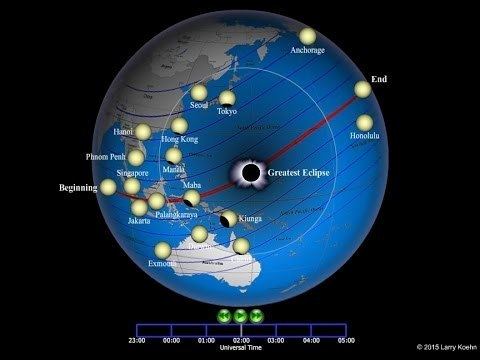Nature Total Magnitude 1.045 Max. width of band 155 km (96 mi) Date 9 March 2016 | Gamma 0.2609 Duration 249 sec (4 m 9 s) Greatest eclipse 1:58:19 | |
 | ||
Other Instances Solar eclipse of April 8 - 2, Solar eclipse of July 2 - 20, Solar eclipse of August 2, Solar eclipse of March 20, Solar eclipse of April 29 | ||
A total solar eclipse took place on March 8–9, 2016. If viewed from east of the International Date Line (for instance from Hawaii), the eclipse took place on March 8 (local time) and elsewhere on March 9. A total solar eclipse occurs when the Moon's apparent diameter is larger than the Sun's and the apparent path of the Sun and Moon intersect, blocking all direct sunlight and turning daylight into darkness; the sun appears to be black with a halo around it. Totality occurs in a narrow path across Earth's surface, with the partial solar eclipse visible over a surrounding region thousands of kilometres wide. The eclipse of March 8–9, 2016 had a magnitude of 1.0450 visible across an area of Pacific Ocean, which started in the Indian Ocean, and ended in the northern Pacific Ocean.
Contents
The eclipse was clearly visible in many parts of Indonesia, including Central Sulawesi and Ternate, but obscured by clouds and smokes in Palembang, the largest city on the path of totality. The eclipse coincided with Nyepi, a public holiday in Indonesia and the end of the Balinese saka calendar. Because Nyepi is normally a day of silence, Muslims in Bali had to be given special dispensation to attend special prayer services during the eclipse.
Path of the eclipse
On March 9, 2016, a large area of the Pacific, covering Indonesia, Malaysia, but also large parts of Southeast Asia and Australia, witnessed a partial solar eclipse. It was total in Indonesia and the central Pacific, starting at sunrise over Sumatra and ending at sunset north of Hawaii. In the Eastern Pacific Ocean, the totality exceeded a duration of more than 4 minutes.
In most parts of India and Nepal, the sunrise was partially eclipsed, and much of East Asia witnessed more than 50% partial eclipse.
The largest city along the path of totality was Palembang in southern Sumatra (423 km (263 mi) from Jakarta and 478 km (297 mi) from Singapore).
Related eclipses
This solar eclipse is related to other eclipses including in the current set predictions between 2015 and 2018. It is also a part of long period Saros cycle 130, and a 19-year Metonic cycle.
Solar eclipses 2015–18
Each member in a semester series of solar eclipses repeats approximately every 177 days and 4 hours (a semester) at alternating nodes of the Moon's orbit.
Saros 130
This eclipse is a part of Saros cycle 130, repeating every 18 years, 11 days, containing 73 events. The series started with partial solar eclipse on August 20, 1096. It contains total eclipses from April 5, 1475 through July 18, 2232. The series ends at member 73 as a partial eclipse on October 25, 2394. The longest duration of totality was 6 minutes, 41 seconds on July 11, 1619.
